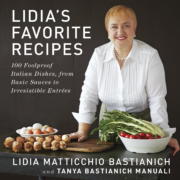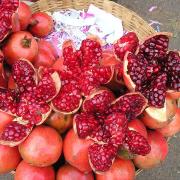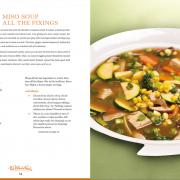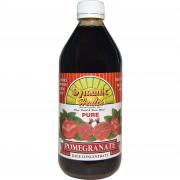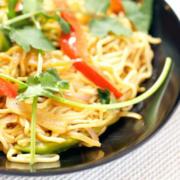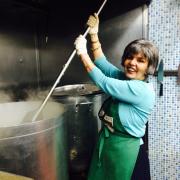Lidia’s Favorite Recipes. Lidia Bastianich. Book Review
Lidia Bastianich’s latest book
I recently received Lidia Bastianich’s latest Cookbook, Lidia’s Favorite Recipes, which her publishers sent me for review. Lidia’s cooking show has always been one of the very few cooking shows I actually enjoy watching, for many no-brainer reasons: It is real food, not a fantasy; it has none of that swashbuckling that often turns a food show into a freak show; it is wholesome; the ingredient list is brief and to the point; the cooking steps are perfectly streamlined; she turns simple ingredients into dishes that are much more than the sum of their modest parts; she is resolutely in the home-cook’s corner; she leaves plenty of freedom for variations on many of the dishes, to accommodate the season and the cook’s personal preferences; the pictures of her dishes, free from all silly props, clearly include cooks from all walks of life.
A cook after my own heart, Lidia Bastianich uses all my favorites and spreads them on really thick: fennel, asparagus, Swiss chard, beets, lemons, tomatoes, rosemary, garlic, olives, beans: yum! And even though I am a Kosher baby who will find some dishes off limits (octopus? Ha, I don’t think so, thanks though!), with just a little creativity, some adaptations are super simple, for all readers that shy away from seafood.
All this and much more comes through beautifully in her new book.
What I find objectionable in Lidia Bastianich’s book:
But by no means a deal breaker. Celebrity chefs being known to have much bigger fish to fry than actually hunker down to writing their own cookbooks, I suspect the following doesn’t have to do with Lidia as much as with her ghost writers and editors:
- After the word “Favorite” has been prominently displayed in her book’s title, why is it still lurking annoyingly, sometimes three and even four times, in most recipe intros? Beside being severely redundant, I am afraid it takes the place of some much more personalized thoughts in the intros.
- Some dishes and their variations, which often amount to several full-length recipes in the book, could easily have been consolidated into one comprehensive dish, with a couple variations at the end of the recipe (for example: risotto, tomato sauce). We would then have enjoyed more of Lidia’s dishes, and reached a hundred of her favorites, as perfectly distinct from one another, quite easily.
- Although for the most part the recipes are pretty straightforward, there was, in a couple recipes, some wording I just could not wrap my head around. Here are two egregious examples that suggest the editor simply is not a cook, or didn’t have clarity on his/her mind when the book went out to press. Consider this line in her wonderful wedding soup recipe: “Tear the bread into chunks, put them in a small bowl, and pour in just enough milk to cover them“: so far so good, albeit not grammatically ideal, but then it goes on… “Let soak until completely saturated, then lift the bread out of the bowl and squeeze out the milk with your fists” If you meant to say soak the bread in the milk, then squeeze it dry and discard the milk, why not just say so? Likewise, with her prune-stuffed roast, I scratched my head in vain on some rough patches, then decided the recipe is just impenetrable; here’s just one excerpt: “Use a sharp knife to cut a 1-inch pocket along the entire length of the eye, around the top half part of the roast. Cut from both sides of the roast until you cut through”. Pray tell: what on earth does this mean?
I have already made the Braised Swiss Chard and Cannellini Beans (page 117), and the Chocolate Bread Parfait (page 207): A snap, and so delicious! Gotta make that wedding soup too, wedding or not!

